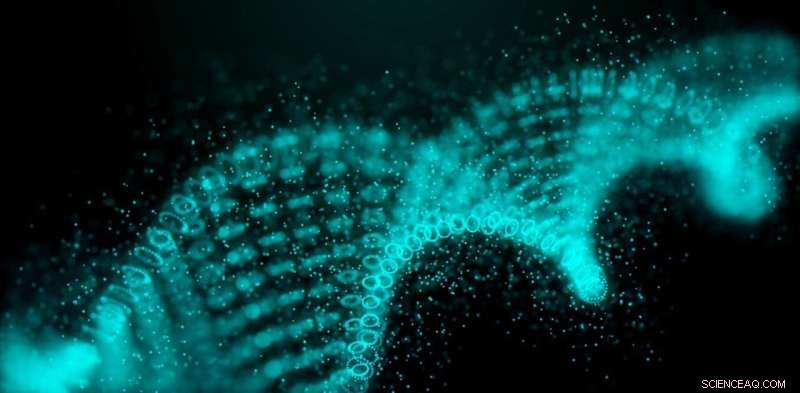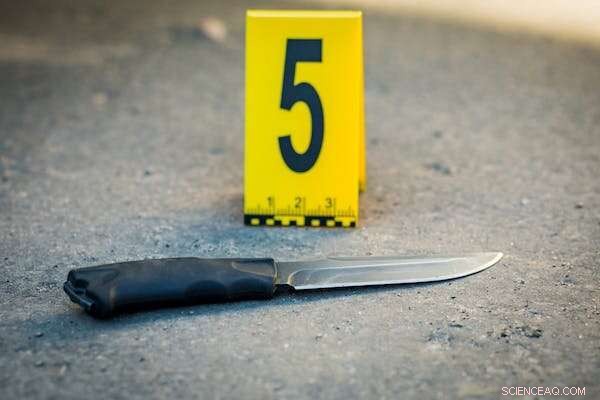
Crédit :thinkhubstudio/Shutterstock
Le profilage ADN fait souvent la une des journaux. L'intérêt du public est suscité lorsque l'ADN est utilisé pour identifier un suspect ou des restes humains, ou résout une affaire froide qui semble presque oubliée.
Très occasionnellement, c'est dans les médias que le processus ne fonctionne pas comme il le devrait.
Alors, qu'est-ce que le profilage ADN et comment fonctionne-t-il ? Pourquoi parfois ne fonctionne-t-il pas ?
Une brève histoire du profilage ADN
Le profilage ADN, comme on l'appelle depuis 1994, est utilisé dans le système de justice pénale depuis la fin des années 1980 et était à l'origine appelé "empreintes ADN".
L'ADN de chaque être humain est très similaire - jusqu'à 99,9% identique, en fait. Mais étrangement, environ 98 % de l'ADN de nos cellules n'est pas lié aux gènes (c'est-à-dire qu'il n'a pas de fonction connue).
Cet ADN non codant est en grande partie composé de séquences des quatre bases qui composent l'ADN de chaque cellule.
Mais pour des raisons inconnues, certaines sections de la séquence sont répétées :un exemple est TCTATCTATCTATCTATCTA où la séquence TCTA est répétée cinq fois. Bien que le nombre de fois que cette séquence d'ADN se répète soit constant chez une personne, il peut varier d'une personne à l'autre. Une personne peut avoir 5 répétitions mais une autre 6, ou 7 ou 8.
Il existe un grand nombre de variantes et tous les humains tombent dans l'une d'entre elles. La détection de ces répétitions est le fondement du profilage ADN moderne. Un profil ADN est une liste de nombres, basée sur les séquences répétées que nous avons tous.
L'utilisation de ces courtes séquences répétées (le terme technique est "short tandem repeat" ou STR) a commencé en 1994 lorsque le UK Forensic Science Service a identifié quatre de ces régions. La probabilité que deux personnes prises au hasard dans la population partagent le même nombre de répétitions dans ces quatre régions était d'environ 1 sur 50 000.
Désormais, le nombre de séquences répétées connues a considérablement augmenté, le dernier test portant sur 24 régions STR. L'utilisation de toutes les régions STR connues donne une probabilité infiniment petite que deux personnes au hasard aient le même profil ADN. And herein lies the power of DNA profiling.
How is DNA profiling performed?
The repeat sequence will be the same in every cell within a person—thus, the DNA profile from a blood sample will be the same as from a plucked hair, inside a tooth, saliva, or skin. It also means a DNA profile will not in itself indicate from what type of tissue it originated.
Consider a knife alleged to be integral to an investigation. A question might be "who held the knife"? A swab (cotton or nylon) will be moistened and rubbed over the handle to collect any cells present.

Swabbing an item left at a crime scene can easily yield enough cells to generate a DNA profile. Credit:Fuss Sergey/Shutterstock
The swab will then be placed in a tube containing a cocktail of chemicals that purifies the DNA from the rest of the cellular material—this is a highly automated process. The amount of DNA will then be quantified.
If there is sufficient DNA present, we can proceed to generate a DNA profile. The optimum amount of DNA needed to generate the profile is 500 picograms—this is really tiny and represents only 80 cells!
How foolproof is DNA profiling?
DNA profiling is highly sensitive, given it can work from only 80 cells. This is microscopic:the tiniest pinprick of blood holds thousands of blood cells.
Consider said knife—if it had been handled by two people, perhaps including a legitimate owner and a person of interest, yet only 80 cells are present, those 80 cells would not be from only one person but two. Hence there is now a less-than-optimal amount of DNA from either of the people, and the DNA profiling will be a mixture of the two.
Fortunately, there are several types of software to pull apart these mixed DNA profiles. However, the DNA profile might be incomplete (the term for this is "partial"); with less DNA data, there will be a reduced power to identify the person.
Worse still, there may be insufficient DNA to generate any meaningful DNA profile at all. If the sensitivity of the testing is pushed further, we might obtain a DNA profile from even a few cells. But this could implicate a person who may have held the knife innocently weeks prior to an alleged event; or be from someone who shook hands with another person who then held the knife.
This later event is called "indirect transfer" and is something to consider with such small amounts of DNA.
What can't DNA profiling do?
In forensics, using DNA means comparing a profile from a sample to a reference profile, such as taken from a witness, persons of interest, or criminal DNA databases.
By itself, a DNA profile is a set of numbers. The only thing we can figure out is whether the owner of the DNA has a Y-chromosome—that is, their biological sex is male.
A standard STR DNA profile does not indicate anything about the person's appearance, predisposition to any diseases, and very little about their ancestry.
Other types of DNA testing, such as ones used in genealogy, can be used to associate the DNA at a crime scene to potential genetic relatives of the person—but current standard STR DNA profiling will not link to anyone other that perhaps very close relatives—parents, offspring, or siblings.
DNA profiling has been, and will continue to be, an incredibly powerful forensic test to answer "whose biological material is this"? This is its tremendous strength. As to how and when that material got there, that's for different methods to sort out.